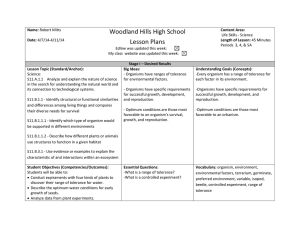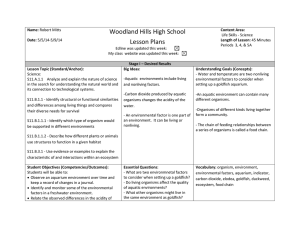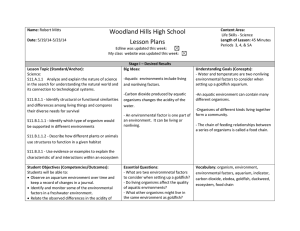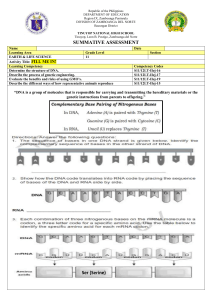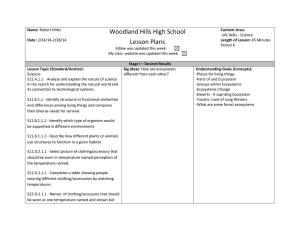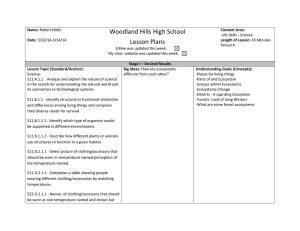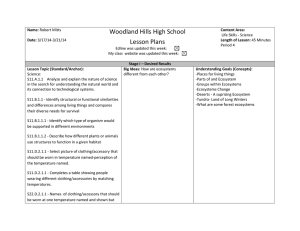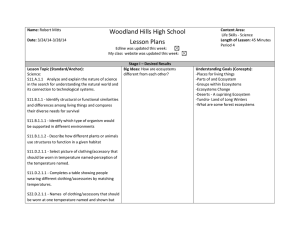Woodland Hills High School Lesson Plans
advertisement
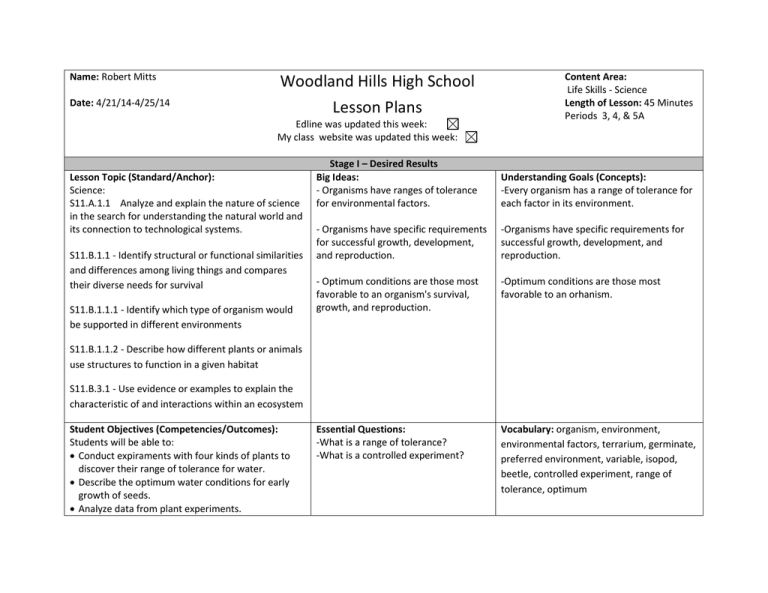
Name: Robert Mitts Date: 4/21/14-4/25/14 Woodland Hills High School Lesson Plans Edline was updated this week: My class website was updated this week: Lesson Topic (Standard/Anchor): Science: S11.A.1.1 Analyze and explain the nature of science in the search for understanding the natural world and its connection to technological systems. S11.B.1.1 - Identify structural or functional similarities and differences among living things and compares their diverse needs for survival S11.B.1.1.1 - Identify which type of organism would be supported in different environments Content Area: Life Skills - Science Length of Lesson: 45 Minutes Periods 3, 4, & 5A Stage I – Desired Results Big Ideas: - Organisms have ranges of tolerance for environmental factors. Understanding Goals (Concepts): -Every organism has a range of tolerance for each factor in its environment. - Organisms have specific requirements for successful growth, development, and reproduction. -Organisms have specific requirements for successful growth, development, and reproduction. - Optimum conditions are those most favorable to an organism's survival, growth, and reproduction. -Optimum conditions are those most favorable to an orhanism. Essential Questions: -What is a range of tolerance? -What is a controlled experiment? Vocabulary: organism, environment, environmental factors, terrarium, germinate, preferred environment, variable, isopod, beetle, controlled experiment, range of tolerance, optimum S11.B.1.1.2 - Describe how different plants or animals use structures to function in a given habitat S11.B.3.1 - Use evidence or examples to explain the characteristic of and interactions within an ecosystem Student Objectives (Competencies/Outcomes): Students will be able to: Conduct expiraments with four kinds of plants to discover their range of tolerance for water. Describe the optimum water conditions for early growth of seeds. Analyze data from plant experiments. Use scientific thinking pocesses to conduct investigations and build explanations: observing, comunicating, comparing, organizing, and relating. Stage II – Assessment Evidence Performance Task: Other Evidence: - Students will conduct experiments, observe, and answer -student work samples comprehension questions -observation -verbal responses Stage III – Learning Plan Materials & Resources: ASSET sciene kit supplies, readings, comprehension questions, and activity worksheets CONTENT AREA READING: Throughout lessons Formative Assessment(s): #1. Pre-Assessment #2. Summarizing Main Ideas #3. Graphic Organizers Others: Instructional Procedures*: (includes mini-lessons) -active engagement, explicit instruction, modeling, scaffolding Scaffolding used: #1. Teacher Promping #2 . Provide Visual Support Others: Describe usage: Describe usage: -at beginning, during, and after lessons -throughout lessons Procedures Active Engagements used: #1. Summarizing #2. Whole Class Response Others: Monday 4/21/14 Day No School Tuesday 4/22/14 Day A Attend the Dress Rehearsal of Sweeny Todd Wednesday Thursday 4/23/14 Day B 4/24/14 Day A Listen to the audio Finish listening to the recording of "Aquatic audio recording of Environments Around "Aquatic the World" Pages 27-30 Environments Around while following along in the World" Pages 31the science story books 35 while following along on the science Answer comprehension Friday 4/25/14 Day B Set up the Aquarium/Observe the aquarium - Journal Worksheet questions about the story See Above See Above See Above Assignments See Above story books Finish answering the comprehension questions about the story * Include Active Engagement, Explicit Instruction, Metacognition, Modeling, & Scaffolding See Above
